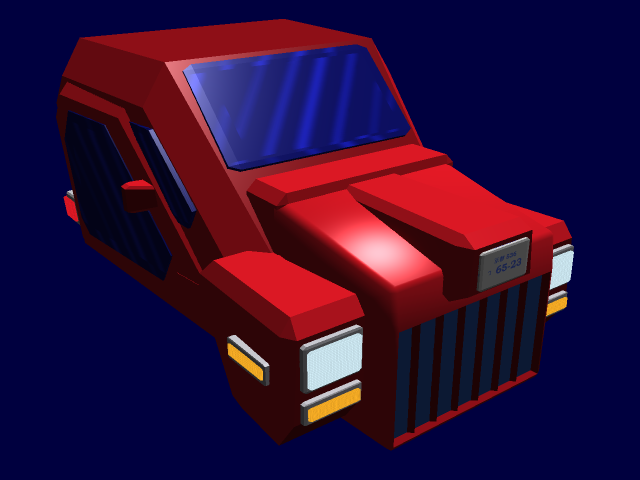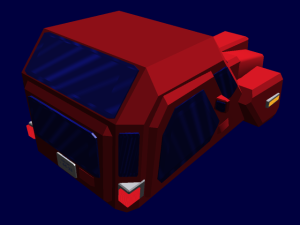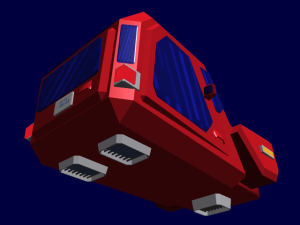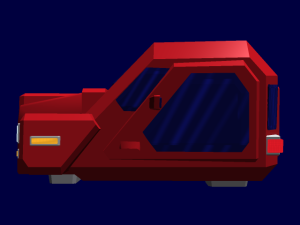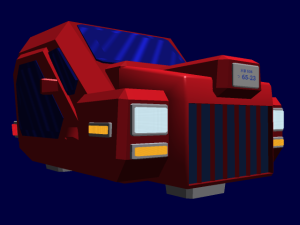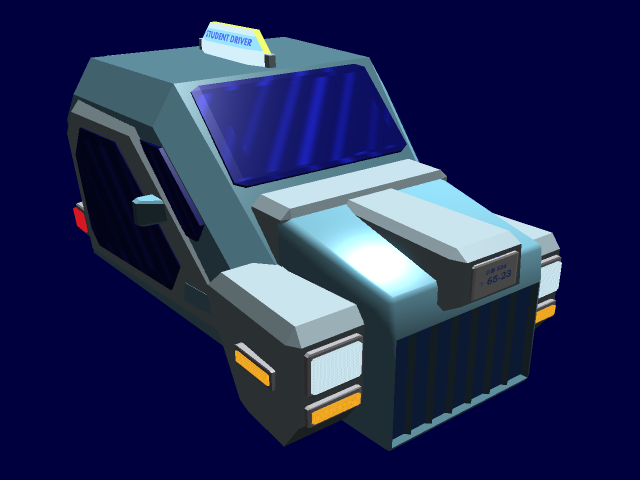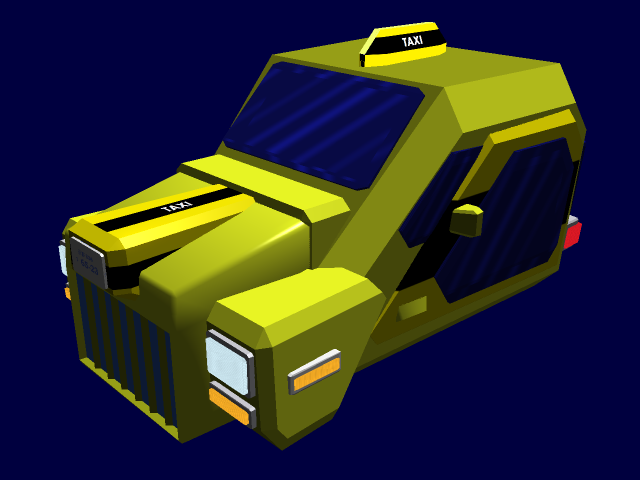Table of Contents
Soyokaze/Windbreaker Cyclecar
Developed in YE 34 by Kage Yaichiro; the Soyokaze(“soft wind”)/Windbreaker Cyclecar is a small vehicle derived from simple airbike technology which places safety, cost, and reliability above style.
About the Soyokaze/Windbreaker Cyclecar
Initially intended to be a cheap and reliable car which children in Tsubomi City could use with the aid of an autopilot, the car's attributes make it a good option for wartime production in the utilitarian and economy niches, as well as for small business owners. It is capable of traveling at a moderate speed with little power, and has the basic elements of a vehicle of its type including a guidance system which allows its use by children and as a taxi. It can seat 4 adults, albeit cramped as the back seats are really intended for children.
The car is also designed to have easy to replace modular parts to minimize labor and repair costs, as well as being programmable to accept alternate instructions or adjustments for aftermarket hardware or additional options. This lends the car to extreme modification by hobbyists, business and taxi services, and use by people who demand a low-maintenance vehicle that will last for years to come.
Soyokaze means “Soft Wind” in Yamatai-go, but feeling the name improper for the Nepleslian markets, the name “Windbreaker” was adopted for the same vehicle in those circles. While it is mentioned to be a reference to the light wind-based attire, there are rumors that it is also named for light flatulence.
Key Features
The Soyokaze, though cheaply produced and utilitarian, has assorted features and capabilities which lend it for use in various roles in addition to assorted packages and options. The craft can fly at 225 kilometers per hour, up to an altitude of one kilometer, and is programmed to go as low to the ground as 30 centimeters in flight. It sacrifices top speed for lateral movement and reasonable acceleration, to maximize its safety and ability to react to road conditions and avoid accidents. Its rear bench seat can fold down to allow room for light cargo capacity instead, allowing it to carry two more people in a pinch or allow a trip to the store.
This functionality is essential because of the cyclecar's ability to drive itself, so that it can be used by those who cannot drive such as children or the elderly. This functionality is robust and able to take advantage of sensors, GPS, wireless communications, verbal input, and even touch screen input in addition to standard controls. The computer can also respond to orders from police, take control from a driver who is critically injured, and make split-second decisions on how to cause a minimal amount of harm in an imminent accident. Additional functionality can be added to the vehicle through the computer system which allows it to function autonomously as a taxi or other service/business vehicle; though this programming normally cannot supersede its basic safety, security, and its response to police. This prevents criminals from using this functionality as a security vulnerability through its wireless systems. Still, vehicles can be equipped with the tools needed for financial transaction and light storage, making them suitable for businesses and service.
Due to the simplicity and low cost of the parts, the vehicle is designed to have modular systems which are easy to replace. Labor costs for working on a stock Soyokaze are extremely low because the parts are swapped out readily and are generally cheaper to replace than to fix. Parts which are removed in this manner are often recycled, though it's not unheard of for parts to wind up being repaired and used as spares or for a project or kit car.
As a consequence of the low price, the modular and cheap parts, and the programmability of the computer system, the Soyokaze lends itself greatly to customization. Parts to modify the vehicle into an automated taxi have been available from the beginning and custom paint jobs have also been available which allow text or corporate symbols; but people can also alter the vehicles with more powerful systems and engines, more aerodynamic bodies, and other such changes. Often, the rear bench seat/storage space is used as a storage space for any additional systems for these modifications, though the drawers under the front seats are also seen gutted for additional room.
History
In YE 33, the Battle of Yamatai damaged a fair amount of Yamatai's infrastructure and population, having effects causing the orphaning of a number of students and causing economic damage. With the founding of Tsubomi City in early YE 34, a low cost vehicle which the children could use for personal transport was needed. In an effort to make a reliable and safe hovercar at a very low cost, simple airbike technologies were explored and utilized to make the Soyokaze in both a personal vehicle role which the children would be able to save up for and afford, while also being able to serve in a taxi and business role.
Partway through the design process it was realized that the vehicle could still carry four people maximum, albeit in cramped conditions. With this in mind, the vehicle's scope was expanded to the consumer market – a vehicle intended not only to make the most of materials in a wartime era and transport children and first time drivers, but to provide a low cost and reliable option to people and hopefully aid in economic recovery into the post-war era. In an effort to mass produce and market the car in Yamataian and Nepleslian markets, Tamahagane Corporation was licensed to make and sell the car under the Emrys Industries label. The name “Windbreaker” was utilized in the Nepleslian markets for the same vehicle.
Appearance
The Soyokaze is a small vehicle which is rather angular and developed to be safe and efficient rather than eye-catching. Its styling is utilitarian and boxy, while still unique compared to other vehicles on the road. It has a main core body, a forward protrusion for various systems, three thrust pads visible on the bottom, and a pair of forward bumpers with lights on them. It also has a full set of headlights, tail lights, turn signals, and a place for the attaching of a license plate on the front and rear if needed.
Statistical Information
Organization: Yamatai Star Empire, Tsubomi City, Civilians Type: Economy Hover Cyclecar Class: PT-K1-1A Designer: Kage Yaichiro Manufacturer: Project THOUGHT (16 Prototypes), Tsubomi City (Unrestricted), Tamahagane Corporation under Emrys Industries label (Licensed) Production: Mass Production
Base Price: 950 KS/1900 DA
Option Prices: Additional 50 KS/100 DA for Custom Colors Additional 50 KS/100 DA for Amateur Radio plus Antenna Additional 200 KS/400 DA for Aether Power System Additional 50 KS/100 DA for Placard Additional 100 KS/200 DA for Programmable Register/Meter with Card Swipe
Package Prices (Including Applicable Options): 1050 KS/2100 DA for Taxi Package 1100 KS/2200 DA for Driving Instructor Package
Crew: 1 (0 possible with Taxi Package) Passenger Capacity: 4 (2 adults, 2 children) Emergency Capacity: 4
Length: 200 cm (78.7 inches) Width: 122 cm (48.0 inches) Height: 106 cm (41.7 inches)
Speeds
Ground speed: N/A Air speed: 225 kmh (140 mph), can operate as low as 30 cm from the ground
Range: 40,000 km/25,000 miles (Fusion), Indefinite (Aether Option) Lifespan: 30 years or greater
Damage Capacity
See Damage Rating (Version 3) for an explanation of the damage system.
- Basic Body: 6 SP (Armor Scale)
Interior
Inside the vehicle can be found two forward bucket seats with the ability to fold down and slide, as well as a folding rear bench seat. The front seats have a storage compartment in their base and detachable food trays attached to their backs. The sliding abilities allow people to more easily get in the rear of the vehicle, and the folding capabilities can also allow storage of light cargo or groceries instead of people. They are made of a synthetic cloth which is resistant to wear and spills. There are no airbags, due to the Safety Pad acting as a crude inertial dampener.
The steering column, known as a Control Console, is also present and can be installed on the right or left side depending on the location in which the vehicle is driven and its road configuration. Installed in it are the Audio Media Component, the Tablet/Communicator Cradle, the Navigator Screen, various buttons including the horn's “rage button”, and either a stick or a yoke. Two panels also exist in which additional optional components can be added.
The color of the interior is based on the exterior, and varies heavily between the vehicles, though the seats are usually lighter in front and darker in the back. The floor has a stain-resistant carpeting on it hiding the Safety Pad and frame underneath, and there are two vents through which air can circulate in the vehicle on either side of the dash area near the doors. There are also two dome lights in the top of the vehicle, for the front and rear seats.
Onboard Systems Descriptions
Computer System
The computer system is an efficient and robust unit which is designed to run for long periods without failing. Unlike the types in conventional vehicles, the computer must be able to calculate the vehicle's position in three dimensional space, its orientation, its vector, as well as that of surrounding objects. It must also be able to identify people as well as its environment, know vehicle law, and make judgment calls on its movement. In order to accomplish all of this, and have a balanced cost, the unit has three independent basic computer systems – two of which are required for the vehicle to operate normally.
Using a trio of less powerful computers provides a level of redundancy, protection for other programs if a computer fails, and a reduction in cost. The buffers between the systems also act in a way to prevent one computer from attacking the others if infected with a virus. If one computer is compromised, the two essential systems can be run on the remaining systems in a special mode geared toward getting the vehicle to safety and avoiding the taking in of corrupt or viral data.
Autopilot/Guidance System
The Autopilot/Guidance system is responsible for the bulk of the decision making in automated piloting, and controls the actual driving. It takes the data given to it by the Identification System and applies vehicular law to it while also determining threats and the driving of other motorists. It is also responsible for analyzing the data from the Identification System and determining the best route to a location. This is essentially the decision making and motor control part of the vehicle. It also controls the lights and signaling.
Identification System
The Identification system manages the sensors as well as the data management and input of the vehicle. It is this module that collects map, wireless, visual, audio, and internal data and feeds it to the Autopilot/Guidance System to be acted upon. This system also identifies drivers who are permitted to unlock and drive the vehicle, and receives commands from law enforcement. This is the data collection and sensory control part of the vehicle. It also controls the radio, music, doors, locks, and climate control.
Variable Function System
Unlike the other computing elements of the vehicle, this one is not essential to the vehicle. Instead, it is a programmable unit which is intended for use when the vehicle is performing a special non-standard duty or is using supplemental components. Taxi cabs, for example, use this module to contain special programming allowing the vehicle to act in its new role – stopping for signaling customers, monitoring the wireless frequencies for fares nearby submitted by communicator, and using the hardware of an installed card reader to perform transactions. Should something happen to one of the computers in the vehicle, however, the Variable Function System will be the first system to be reallocated to critical systems. This is due to it not being essential to the safe operation of the vehicle.
This component, however, is largely available in standard variants, and is such an element used in modification. It can hold code to more efficiently allow a modified Soyokaze to utilize upgraded parts, for example. Another use is the addition of a standard operating system to unlock the extra computing system to conventional use as a small but functional car-based multi-purpose computer with wireless capability. Should the Variable Function System be reallocated to a more integral system on a vehicle which has upgrades on it, the upgrades will not be pressed beyond the tolerances of their stock counterparts.
Control Console
The Control Console is the fixture through which the driver controls the Soyokaze. It is a single removable console, which can be moved across the dash to be used from either of the two front seats. Because of this function, the vehicle can be cheaply and uniformly produced for more markets, regardless of left or right-sided road configuration.
It holds a stick or a yoke for control, various gauges and control buttons, the horn's “rage button”, ventilation knobs, the Audio Media Component, the Tablet/Communicator Cradle, the Navigation Screen, and up to two optional components such as the Amateur Radio or other expansions. The vehicle comes with a stick and a yoke, which the user can readily install either of as a matter of preference. The gauges are a barometer, a speedometer, an altimeter, and a fuel gauge – though with the Aether Power System, the fuel gauge is replaced with a more complex Aether Generator Status display.
It is also possible to have two control consoles in the same vehicle with one subordinate to the other, an optional configuration intended for driving instructors.
Doors
The Soyokaze has two side doors and a door at the rear. Unlike most doors, these open upward on a track. Not only does this make them easier to open, but it minimizes scratches and dings caused by its drivers and passengers going in and out. The tracks are also designed to hold the door upward once it is opened, make the door open gently with no force once it is opened, and close without a great deal of exertion. These doors are also easy to open if the vehicle crashes in water, allowing escape and an increased survival rate.
Another noteworthy element is that a physical key is not required – the vehicle's sensors determine if the person attempting to gain entry is permitted to do so, or if a group of people has with them such a person. The side doors can be opened and closed by manipulating the mirror built onto them, and all the doors can be opened by the indentation which is lower on the vehicle. This indentation, however, can also be used with the foot – gently pulling the door up briefly with the leg and letting the door rise if carrying a load.
Frame
The basic frame of the vehicle is Durandium Alloy, with the windows being constructed of Transparent Durandium. The craft uses a semi-monocoque design, though the front fenders and license plate holder are removable components designed to absorb damage and be replaced. The doors are also removable, and are a large surface area of the vehicle. It is notable that the frame relies on simplicity to provide its occupants with a very safe and structurally sound area to endure collisions, which is also cheap enough to produce to warrant replacing the frame of the vehicle. A Soyokaze which has frame damage can conceivably have its frame swapped with a new one in a weekend by the owner to save on labor, and be deemed roadworthy after an inspection. This is in distinct contrast to other more complex vehicles, which are often totaled in this scenario.
Fusion Power System
The stock power system within the Soyokaze is notable for not being an Aether System, but still extra long range due to the vehicle's size. It is a simple Nuclear Fusion Reactor, which is efficient and capable of a range of 40,000 km, or roughly 25,000 miles. This figure, however, may vary depending on aftermarket upgrades. An optional Aether Power System can be purchased instead, at an increased cost.
Horn
The horn of the Soyokaze is unique to say the least. Though it comes with pre-set sounds of horns, it is also possible to program one's own sounds into the horn or even select a group of sounds to randomly play from. Because of this, the vehicle can produce all manner of alert sounds. The presets are relatively tame but the custom ones can range from annoying song tones, to distracting moans, to strings of profanities, and even to the sound of automatic weapons fire. Some sounds, such as those mimicking the sirens of emergency vehicles, are outright illegal and should not be used.
The horn is used by pushing a large button on the Control Console, one designed to require fair resistance to keep it from being accidently pressed. Because of the size, and the fact it is sturdy, users can sometimes get enjoyment from slamming their fist down on the button to get their desired sound. Because of this satisfying fist-slamming capability to deliver a pre-recorded sound representative of the driver's feelings, the horn's button is also known as the “rage button”.
Lights
The lights of the Soyokaze are fairly standard, though instead of having high and low beams, the lights are high duration and output LED bulbs which can have their intensity modulated by the driver or by the computer. The dome lights inside the car over the front and rear seats and the gauges also use the same type of variable intensity LEDs, which can detect the ambient light outside and set the light to the proper level. If approaching a tunnel or the like, the lights will adjust ahead of time.
It should be noted that the headlights and taillights of the Soyokaze are on by default when the vehicle is running, albeit at a low intensity. This allows for improved visibility of the Soyokaze by other drivers. They can be configured to work as they do on other vehicles, however. The dome lights usually only function while the doors are open, or are physically pressed on and off, unless programmed to do otherwise.
Propulsion
The propulsion is provided by a trio of gravimetric thrust pads. They also allow the vehicle to hover in mid air and rotate in a fixed position, or even move sideways for precision movement. They make parallel parking and lane changes particularly easy.
Safety Pad
Another gravimetric thrust pad coupled to a high density capacitor can be found concealed inside the vehicle, but it is not part of the main propulsion system. It has two main functions, the first being to carefully help the vehicle descend if a catastrophic failure occurs. The other purpose is to manipulate the forces within the passenger area of the vehicle in a sudden acceleration or deceleration, as a simple inertial dampener. This component keeps the passengers in their seats and upright, is intended to prevent whiplash, negates the need for airbags, and is safer for all ages. It can also, to a limited extent, help the car's cabin to avoid extra damage.
Seats
The seats in the Soyokaze are meant to function well in the small vehicle, and allow their occupants entry into the super-compact cyclecar as well as being sturdy. They are made of a synthetic cloth which is resistant to wear and spills. The front two seats are separate bucket seats with the ability to fold forward and slide back and forth to a significant degree, with whichever seat is acting as the passenger seat even being able to slide all the way up to and partially under the dash even when folded down. This allows the passengers to more easily get into the back seat, and also adds room when the driver is alone transporting light cargo. The front seats are also equipped with a tray built into the backs which has cupholders on it, and can flip out at waist level for the people in the back to set their food and drink on. These trays can also be removed entirely and held in the lap by anyone, or be used while affixed to the back of the acting passenger seat if completely folded over. Due to the lack of a glove compartment, these seats have lockable drawers built into the base which serve to store various items.
The rear seat is a bench seat that seats two, lacking the ability to slide forward or backward and having no lockable compartment underneath. Instead, the seat can be readily pushed down close to the floor and folded over, creating extra storage space in the back of the vehicle. While it is not an uncomfortable or unsafe seat, the cushioning is thinner than on the front seats so as to minimize the profile of the seat when folded down to allow cargo. The layers of cushioning material gradually get denser in the back seat to allow this.
Seat Belts
The seatbelts of the Soyokaze, while not essential due to the thrust pad added to keep the forces in the vehicle in check, are still provided to ensure protection and legality. These are built into the seats themselves, and consist of a waist buckle for all passengers with an independent pair of shoulder buckles which can buckle into the waist buckle for use by teens and adults as a four point harness. This design, since it is not asymmetrical, allows the left and right bucket seats to be interchangeable and reduces the number of different parts needed in production. The rear bench seat has the same buckling options, for two additional passengers.
Sensors and Communications
The Soyokaze is equipped with an array of cameras, a Crystalline Audio Sensor Array made of single crystals for simple 3D processing of sounds, a barometer, a speedometer, an altimeter, and sensors for the amount of fuel stored. It also possesses wireless communications connectivity and a citizen's band radio. Some units may also have an Amateur Radio and Antenna option installed, but this requires a license in areas where it is legally needed. Additional sensors for monitoring the Aether Generator are installed with the Aether Power System Option.
Cargo Capacity
The vehicle can carry between one and four people. Its seating and cargo storage permutations allow for a variable amount of storage, the largest amount of storage being roughly comparable to a week's worth of groceries for four people or a month's worth of groceries for one person.
Standard Equipment
Audio Media Component
Analog/Digital Radio
Stock music and news capabilities for the Soyokaze are provided by the radio system which not only picks up analog radio signals, but also digital radio signals. It is also used as a pass through to play audio data from the Navigator Screen and other connected systems.
Citizen's Band/SYNC Communication
A built-in microphone can be used to send radio transmissions over Citizen Radio bands or phone calls over SYNC, and the unit can also receive digital audio data from SYNC as well. If preferred, the Tablet-Communicator cradle can connect to and use an alternate device for the phone call capability. the Citizen's Band functionality can be removed or altered depending on the laws of the market in which the Soyokaze is sold. In other markets, networks and protocols other than those used by SYNC may be utilized.
Data Disk Player
The Audio Media Component can be used to play various formats of disks and memory with audio data on it. It can cater to a variety of formats, and is intended to serve most audio needs. Data saved on a tablet or communicator in an audio format can also be played through the cradle.
Tablet/Communicator Cradle
The Tablet/Communicator cradle is not only a charging station on the Control Console for most types of portable communication devices including game systems, but it can also use the communications capabilities of such devices. It can even use the saved numbers and audio data in such devices for playback. It serves the additional purpose of keeping the device secure and from getting lost.
Navigator Screen
A touchscreen exists built into the vehicle which can be used for showing a map of the area and its streets, much like earlier GPS systems. However, this also can be used to interface with the Audio Media component to access various functions. It can also manage elements of the Variable Function System.
Some aftermarket modifications involve using this screen to access more advanced functions.
Ventilation
Ventilation for the car is rather simple; the air entering the vehicle's grill gets heated, cooled, or left as-is before being circulated around the vehicle's interior. The vents have five speeds, and the mix of hot and cold air can be finely adjusted by the control console. In the event that the vehicle crashes into the water, an onboard oxygen tank lasting for six hours can be used if the vehicle's interior does not leak from damage.
Options
Aether Power System
This option replaces the fusion system in the vehicle with an aether-derived one, taking up the same space in the vehicle. The aether system installed is larger than the briefcase sized models, but puts out comparable power due to being designed more cost-effectively and with more shielding to prevent damage. It is intended to be reliable with little to no servicing, though the computer software will monitor the added component and warn if it requires calibration or servicing at a dealer. The gauges of the vehicle's Control Console are also altered to reflect this alteration, with the fuel gauge replaced with a more complicated Aether Generator Status display.
The Aether Power System is an upgrade intended for vehicles which must run for long periods of time autonomously, such as taxis, though it is a popular upgrade for those adding power-intensive aftermarket modifications or for those who just don't feel like fueling up on rare occasion.
Amateur Radio
A mainly Nepleslian system, the Amateur Radio is an STL communications outlet used since before recorded history. It is most commonly used by truckers who wished to engage in raw and unencrypted communication independent of or not fully reliant upon a government-managed infrastructure. It is thus, though primitive, a more freeform and robust broadcast communication system which is useful in an emergency situation when infrastructure is inaccessible or damaged.
While an uncommon option on some worlds, the Soyokaze can be equipped with an Amateur Radio system tuned to comply with the regulations of any planet with laws in place governing it. This takes up one of the slots on the Control Console, and comes with the installation of an external antenna on the vehicle.
Antenna
An external whip antenna for this system is installed on the top of the Soyokaze's roof along the side. Though it adds height to the top of the vehicle, it still does not reach the height limitations of a normal passenger vehicle and thus does not interfere with daily use. Its profile is also lower than the doors when the vehicle is open, and it is thin enough not to obscure the vehicle's sensors nor the appearance of a placard if installed on top of the vehicle.
Custom Colors
Custom colors are available for the Soyokaze for both the exterior and interior of the vehicle for a reasonable price. A wide array of colors are available, as are custom text and graphics on the paint. This allows businesses to readily use the Soyokaze as a chear and robust fleet vehicle.
Placard
On the top of the Soyokaze, a placard with custom text and graphics can be installed with an LED light managed from the Control Console. This is generally used for taxis or business vehicles.
Programmable Register/Meter with Card Swipe
Originally intended for Taxis, this Programmable Register/Meter tracks mileage and funds and can be used to perform transactions as a mobile cash register or as an automated taxi fare payment system. Using the software in the Variable Function System of the Soyokaze, it can be programmed to do many things depending on the needs of a business, and interface with the Navigator Screen. It takes up a slot on the Control Console. It is intentionally difficult to alter the meter's internal hardware, to prevent inaccurate tracking and excessive charging of services.
Even if the meter is not used directly for taxi purposes, it can track how far different personnel are driving and compare it to how much they make and over how much time – to determine the most productive areas in a territory and to more properly allocate personnel.
Packages
Driving Instructor Package
The Driving Instructor Package is a package intended for vehicles which will be used by students learning to operate vehicles. In addition to the existing safety elements and AI guidance options, a second Control Console is added which overrides the first. They are labeled with “Student” and “Driver” in Yamatai-go, Trade, or any other language desired. These Control Consoles also come with the ability to swap in a Stick or a Yoke, so a student can learn to use either or both in the same vehicle. A Driving Instructor uses this configuration to override the student's input if necessary and demonstrate essential skills.
This Driving Instructor Package comes with customized paint and interior, as well as a Placard.
Taxi Package
A Taxi Package is designed to function autonomously along a route or within an area and respond to hails, earning fares with transporting customers and their goods with as little maintenance and as small a force of drivers as possible. In addition to being able to pull over for fares in the conventional manner, fares can be pre-paid and planed out or spontaneously requested via a wireless device as needed – to which the closest available vehicle can respond. A user can then vocally voice their destination to the car or input it via the Navigator Screen.
This particular package, in addition to coming with a placard and custom colors, also comes with the Programmable Register/Meter with Card Swipe. This normally acts as a meter for tracking the distance traveled on a fare and accepts payment via KS, GS, DA, or any currency it is programmed to accept. Some of these vehicles also tend to lock their doors once in transit, and if a user cannot or will not pay their fare upon arrival, will drive themselves to the police station or contact law enforcement after ten minutes. Other taxis require the user to pay before transport, based on the distance calculated by the computer system, like in Tsubomi City. All can lock their doors and report to law enforcement if vandalism of the vehicle is committed.
Emergency transport to hospitals or a police station are free, though the authorities will be alerted to the taxi's situation and be waiting for its arrival…using this to get a free ride without an emergency can be a criminal offense.
Aftermarket Modifications
The aftermarket potential of the vehicle is extensive, in part because of the generic airbike parts used in the vehicle and also because of its design elements. It isn't uncommon for a container or a supplemental system to replace the rear seat, for the Aether Power System to be used to power supplemental devices, or for the Variable Function System and Navigator Screen to be reworked into a fully functional car computer with SYNC (or equivalent protocol) access. Custom hardware can be connected via the Control Console's two ports, or even the interface for the second Control Console on the vacant side of the vehicle. More powerful systems for hovering and thrust can also be added.
Because the vehicles can be heavily modified and programmed, the companies producing and servicing them do not accept responsibility for supporting such modifications, and unapproved upgrades can void warranty or insurance responsibility for the Soyokaze in the case of a breakdown or accident unless properly approved. That being said, there are avenues for submitting modifications for testing and possible approval and sale.
| Products & Items Database | |
|---|---|
| Product Categories | vehicles |
| Product Name | Soyokaze/Windbreaker Cyclecar |
| Nomenclature | PT-K1-1A |
| Manufacturer | Tamahagane Corporation |
| Year Released | YE 34 |
| Price (KS) | 950.00 KS |
